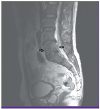1. Ryu SY, Kim HA, Park J, Choe M, Kwon K.
Brucella prostatitis: a first case report diagnosed in Korea. Korean J Pathol. 2011; 45:Suppl 1. S66–S69.
2. Pappas G, Akritidis N, Bosilkovski M, Tsianos E. Brucellosis. N Engl J Med. 2005; 352:2325–2336.

3. Skalsky K, Yahav D, Bishara J, Pitlik S, Leibovici L, Paul M. Treatment of human brucellosis: systematic review and meta-analysis of randomised controlled trials. BMJ. 2008; 336:701–704.

4. Colmenero JD, Ruiz-Mesa JD, Plata A, Bermúdez P, Martín-Rico P, Queipo-Ortuño MI, Reguera JM. Clinical findings, therapeutic approach, and outcome of brucellar vertebral osteomyelitis. Clin Infect Dis. 2008; 46:426–433.

5. Lim HS, Song YG, Yoo HS, Park MY, Kim JW. Brucellosis: an overview. Korean J Epidemiol. 2005; 27:26–36.
6. Guerra H. The brucellae and their success as pathogens. Crit Rev Microbiol. 2007; 33:325–331.

7. Jang Y, Kim H, Bang HA, Lee MJ, Che NH, Lee WC. Epidemiological aspects of human brucellosis and leptospirosis outbreaks in Korea. J Clin Med Res. 2011; 3:199–202.

8. Kim SH, Kim KP, Han S, Kim YR, Kang SH. A case of acute myeloid leukemia developing after treatment for brucellosis with pancytopenia. Lab Med Online. 2015; 5:157–160.

9. Ariza J, Bosilkovski M, Cascio A, Colmenero JD, Corbel MJ, Falagas ME, Memish ZA, Roushan MR, Rubinstein E, Sipsas NV, Solera J, Young EJ, Pappas G. International Society of Chemotherapy.
Institute of Continuing Medical Education of Ioannina. Perspectives for the treatment of brucellosis in the 21st century: the Ioannina recommendations. PLoS Med. 2007; 4:e317.
10. Ablon G, Dayan SA. Randomized, Double-blind, Placebo-controlled, Multi-center, Extension Trial Evaluating the Efficacy of a New Oral Supplement in Women with Self-perceived Thinning Hair. J Clin Aesthet Dermatol. 2015; 8:15–21.
11. Solís García del Pozo J, Solera J. Systematic review and meta-analysis of randomized clinical trials in the treatment of human brucellosis. PLoS One. 2012; 7:e32090.

12. Yoon H, Moon OK, Lee SH, Lee WC, Her M, Jeong W, Jung SC, Kim DS. Epidemiology of brucellosis among cattle in Korea from 2001 to 2011. J Vet Sci. 2014; 15:537–543.

13. Rubach MP, Halliday JE, Cleaveland S, Crump JA. Brucellosis in low-income and middle-income countries. Curr Opin Infect Dis. 2013; 26:404–412.

14. Park MS, Woo YS, Lee MJ, Shim SK, Lee HK, Choi YS, Lee WH, Kim KH, Park MY. The first case of human brucellosis in Korea. Infect Chemother. 2003; 35:461–466.
15. Kim YS, Sill CY, Oh WS, Kwon KT, Lee H, Lee SH, Son JS, Kim SW, Chang HH, Jung SI, Ko KS, Park MY, Peck KR, Song JH. Clinical characteristics of human brucellosis in South Korea. Infect Chemother. 2006; 38:334–343.







 PDF
PDF ePub
ePub Citation
Citation Print
Print



 XML Download
XML Download